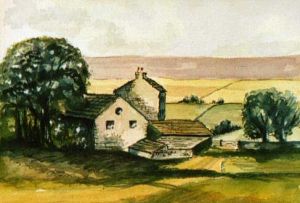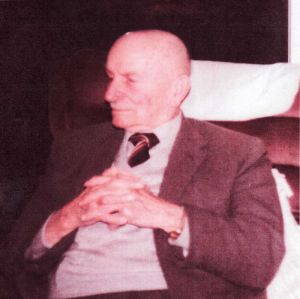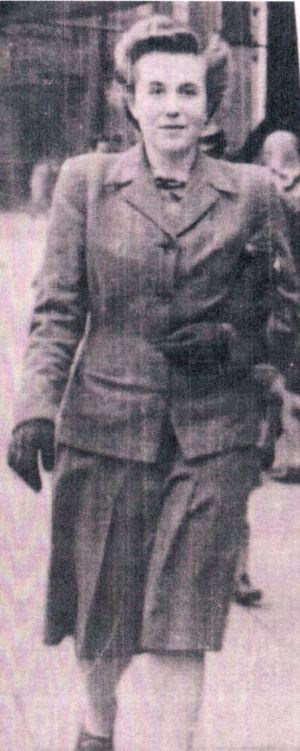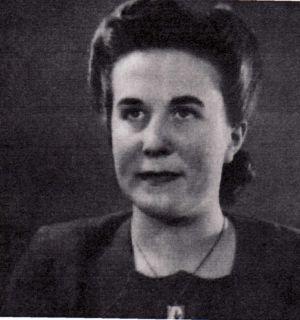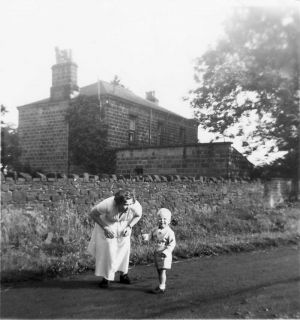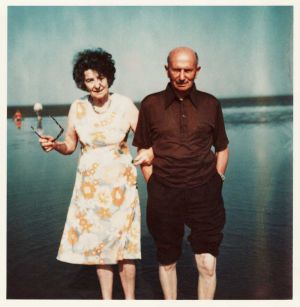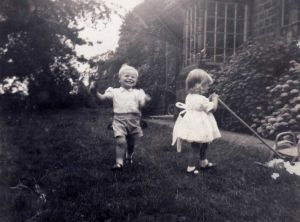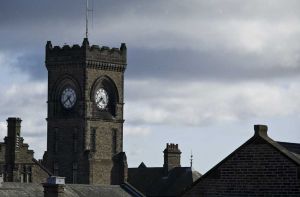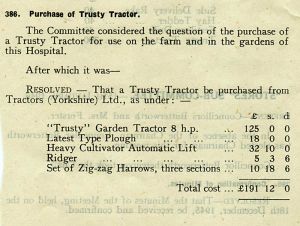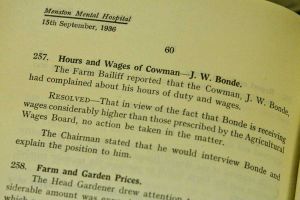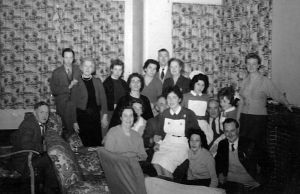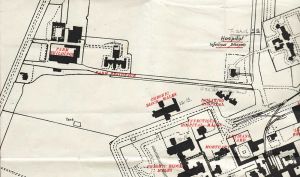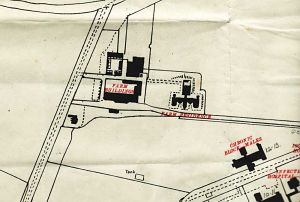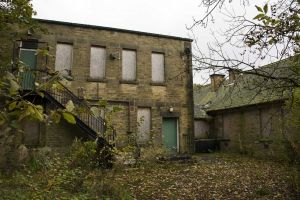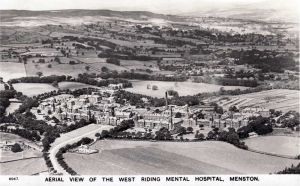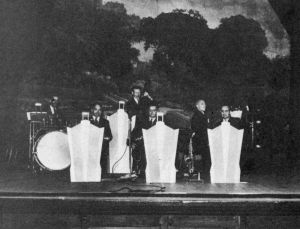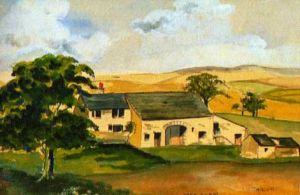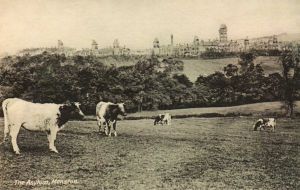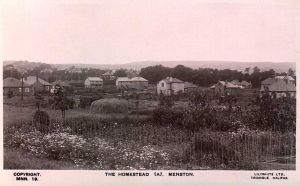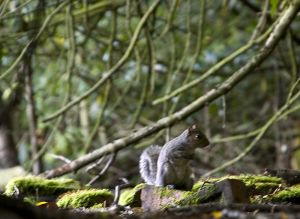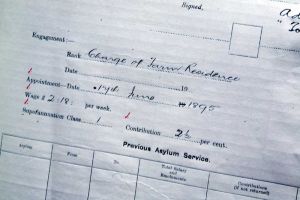G.W. Bitton – Holme Farm We are extremely honoured to share with you this fascinating snapshot of history at Holme Farm.
The Farm Bailiff from 1931 – 1954 was G. W. Bitton and it is his daughter Dorothy who has donated the images and story. Dorothy has many fond memories of living at the hospital farm and recalls the characters and events from her time there. Many of the more capable patients would help with the day to day running of the farm including the large milking herd, flocks of sheep and pigs. They would transport the animals to Mr Kell, at the High Royds slaughterhouse who would kill the animals for use to feed the patients and staff. “I remember one chap, Len Turner, who I sometimes accompanied out with the sheep and he taught me how to whistle! I noticed a photograph of the hospital football team on the website and his son Edgar, was one of the players.” “There was a time in 1947 when the snow was so high it was waist deep and all the doors were blocked. My father designed a snow plough pulled by the horses which cleared the driveway and all the able patients were tasked with their shovels to dig an access to all the blocks”. Dorothy attended Prince Henry’s School, and Menston and lived at the hospital throughout the war years. She remembers attending the wonderful concerts at the ballroom and also playing badminton there every week. We hope to bring you more of her recollections soon. Self Sufficiency
The site of High Royds in the rich Yorkshire countryside of Lower Wharfedale, and the importance given from the very earliest days to the concept of a self-sufficient community, meant that farming and the needs of the land were a central feature of life in the institution. In total there were four separate farms – Thorpe, Norcroft, Odda and Home Farm – with over 600 acres of land. Local men were employed to do much of the farm labour, and were paid an extra supplement for working alongside the patients. Tasks undertaken by patients were usually fetching and carrying churns of milk and sacks of grain, as well as helping to look after the animals.
An early report in the Visiting Justices’ Book, dated 1889, recommended the arable land should be planted with seven acres of potatoes, three-and-a half acres of cabbages, seven acres of marigold and swedes, six-and-a-half acres of oats and seven acres of clover. It was calculated this would require seeds costing about £30, and 160 tons of stable or peat manure would also be needed. Although the terrain proved unsuitable for some types of agriculture – corn growing was not a success due to the rocky ground –the farm produced large quantities of wheat, oats and barley did a great job of feeding the asylum and by all accounts was highly profitable, not least in terms of the tremendous amount of money saved as the patients and staff could be fed almost exclusively with home-grown produce The hospital had its own beautiful shire horses to help plough the fields, and milk and other dairy products came from a flock of Ayrshire heifers, brought down direct from Scotland to the station at Menston. Catastrophe struck in this well-ordered world in 1913, when an attack of swine fever resulted in the slaughter of 333 pigs – an indication of the scale of the farming enterprise. However, things soon recovered, and farming – more mechanised as the years went on – continued to be a major undertaking for years to come, providing many patients with a very small window onto the wider world. As the role of the asylum began to change, interest in self-sufficiency faded and the farms and their cottages were gradually sold off. Although work was still needed to maintain the extensive grounds, an essential and unique part of the character of the site vanished forever Farming The Land The land around High Royds Hospital was originally farmed by tenant farmers, and each farm had stone walls around it’s fields to denote the boundaries of the farm. They were called Holme Farm, Odda, Thorpe and Norcroft.
The land was owned by Mr Fawkes, and when High Royds Hospital was developed it was government funded although the land still belonged to Mr Fawkes. The walls around the small farms were taken down and used to build the boundary to the hospital. At that time the clock tower had a fancy top like a pagoda built in wood but that was taken down a long time ago. High Royds farm covered 630 acres of land and eleven men were farming them. Certain patients were allowed to help and they lived in a building near Holme Farm. There were cowmen and ploughmen, pigmen and stockmen, horsemen and stablemen and they all worked on different areas of High Royds. The pigs and milk were at Holme Farm, rearing stock at Norcroft, older stock at Odda ands dried off cows at Thorpe until they came into milk again. They used to buy Ayreshire Heifers, two year olds, they would come down from Scotland to the railway station in Menston and would be unloaded and walked up Cleasby Road along to Holme Farm.
The hospital did have its own railway which came off a spur from the main line and under the tunnel that goes under the main road, but cows couldn’t come that way because there wasn’t an unloading place for them to get off. At Holme Farm the milk produced was cooled down, put in churns and sent for use at the hospital. From 70 – 80 cows there would be about 1600 pints which was used to feed the patients and staff. There was a slaughterhouse too, mostly pigs, again for the hospital meals and some was sold to a local butcher. In 1939 there were eleven or twelve shire horses in the stables which did the majority of the work with just one tractor. A great deal of time was spent shoveling coal to fill the hoppers. This was to run the giant boilers for heating the water. The hospital also had its own generators for electricity. At Thorpe they grew potatoes, turnips, sugarbeet, mangolds and corn in the fields. The hospital also had its own fire and the farm men who were on duty at night got paid extra. Two men would have to sit on top of the clock tower all night and watch for fires, and during the war years, enemy aircraft.
………………………………………………………………………………………
EXTRACTS FROM THE PROCEEDINGS OF THE MENTAL HOSPITALS BOARD APRIL 1931 – MARCH 1932. MENSTON MENTAL HOSPITAL SPECIAL MEETING OF “FARM” SUB – COMMITTEE 5th May 1931 PRESENT :- Alderman Fawkes, Chairman Aldermen Sutton and Walker Councillors Barrett, Jackson, Mrs Lightowler and Renwick. The Committee received and considered a letter dated 25th April 1931, from Mr.J.C.McGrath, Clerk of the County Council, in regard to the recent outbreak of Foot and Mouth Disease at Thorpe Farm, Menston, and as Clerk to the Local Authority calling the attention of the Mental Hospitals Board to the conduct of the Farm Baliff prior to the discovery that Foot and Mouth Disease existed at Thorpe Farm. The Committee interviewed Mr.Ackroyd, the Farm Baliff, ad received from him a detailed Report of the action he took with regard to both pigs and heifers from Tuesday 10th March, 1931. In the first place Mr.Ackroyd stated that the first intimation from the Pig Attendant at Thorpe Farm that the Pigs were “ricketty” was not received by him until Tuesday morning the 10th March, and not Monday, the 9th March as stated by Mr.McGrath, and that when he went to examine the animals, he found that one pig only (out of the batch of 11 pigs) was crambly and stiff and that this condition was fairly common in pigs during the winter months. On the following day, 11th March, his examination shewed no change. On the 12th March, he found a second pig crambly and stiff but all the pigs seemed hearty and well and cleaned up their troughs. After visiting the Mistal the same morning he saw several store heifers and had them turned out into the yard. Only two shewed any signs of stiffness and this he put down to the rough condition of the ground and not to tender feet. The heifers were not dull but consumed their food heartily and cleaned up. On the 13th March his examination shewed no change, two pigs and two heifers being stiff as previously noted.
On the 14th March he noticed that three more pigs and one more heifer exhibited stiffness and that the heifer in question had saliva running from the mouth. The condition of this animal immediately aroused his suspicions as to the existence of Foot and Mouth Disease and he forthwith called in Mr. Watson, M.R.C.V.S., of Bradford, who reported the same to the Chief Veterinary Officer at the County Hall, Wakefield. Mr.Rabagliati attended at Thorpe Farm about 12noon and after examining the cattle stated that he thought that they were suffering from Foot and Mouth Disease. This was definitely confirmed later. With regard to the statement that although Mr. Rabagliati visit the Home and Norcroft Farms on the 10th March, and Mr. Ackroyd’s House on the 12th March, the Farm Baliff had not sought his advice as to the ailing pigs and heifers at Thorpe Farm, Mr. Ackroyd reported that it never occurred to him to mention the subject to Mr.Rabagliati, as he considered the two pigs and two heifers were only crambly and stiff and as they were eating their food well and heartily he thought the lameness would pass off. The first occasion when his suspicions were aroused as to the existence of Foot and Mouth Disease was Saturday 14th March, 1931, when immediate steps were taken to deal with the outbreak. Mr. Ackroyd stated that Mr.Powley, the Representative of the Ministry of Agriculture, who had attended before the Farm and Visiting Committees on the 17th March, 1931, and gave his history of the outbreak, informed him that he did not attach any blame for any neglect to any of the staff and that he had done everything that was reasonable and proper. Resolved that it be recommended – That after hearing the detailed explanation of the Farm Baliff, this Committee unanimously exonerate him from all blame in the matter and that the Clerk be directed to forward a reply to Mr. McGrath’s letter on the lines above indicated. That on account of Mr.Ackroyd’s physical state of health, the Medical Superintendent be asked to approach him with a view to obtaining his resignation as Farm Baliff and that the consideration of such resignation be dealt with at the next Meeting of the Farm Committee on the 19th May, 1931. RESOLVED – That the Chairman and the Farm Baliff purchase necessary food stuffs for the cattle pending the release of food stuffs now stored at Thorpe Farm.
………………………………………………………………………………………..
18th August 1931 41. The Medical Superintendent reported the resignation of Mr. C. Atkinson, Head Gardener at the Institution. RESOLVED – That the question of the resignation of Mr.C.Atkinson be received with regret and the Committee place on record their appreciation of his past services at the Institution. 42. RESOLVED – That the question of the appointment of a Head Gardener at the Institution be referred to the Chairman and Vice- Chairman of the Visiting Committee and the Chairman of the Farm Sub Committee, for consideration and report.
……………………………………………………………………………………..
15th September, 1931 Appointment of Farm Baliff Your Sub- Committee beg to report that they have gone carefully through the applications received for the appointment of Farm Baliff at the Mental Hospital, and have selected the following six candidates to appear before the Visiting Committee for a final selection:- Name Age Present appointment Henry Potts 34 Assistant Farm Manager,Co-operative Society, Dunfermline, N.B. G.W. Bitton 31 Farm Baliff, Golf Links Farm, Tadcaster Geo.Mallinson 42 Farm Manager, Nun- Appleton Hall, York. Wm.H.Higgott 36 Farm Baliff, Stafford County Mental Hospital, Burntwood, Lichfield. Charles E. 31 Farm Baliff, Hassop Estates co., Bakewell, Shepherd Derbyshire Jasper Wood 45 Farmer, Derry Hill, Menston Signed – F.H.Fawkes, Chairman Pliny Barrett Miriam Lightowler RESOLVED – That the Report be received.
……………………………………………………………………………………
20th October 1931 FARM SUB – COMMITTEE 94. It was reported that Mr.G.W.Bitton, the newly appointed Farm Baliff, would commence duty on Friday, the 23rd October, 1931. 95. RECOMMENDED – That the services of Mr. Ackroyd be continued for a period of two weeks from 23rd October, 1931, for the purpose of initiating the new Farm Baliff. VISITING COMMITTEE 16th February, 1932. 129. The Medical Superintendent submitted a letter he had received, signed by several gardeners at Menston, complaining that employees of the Mental Hospital were working in their spare time and that in certain cases they were paid in kind and they were disposing of the goods in the Institution. RESOLVED – That the Medical Superintendent be requested to inform the complainants that in the absence of any specific charge the Committee regret they are unable to take any action in the matter. 131. The Committee considered the question of the salary of Mr.Arthur Dawson, who was appointed Head Gardener at the Mental Hospital, as from the 1st October 1931. RESOLVED – That the Board be recommended to agree to the commencing salary of Mr. Arthur. Dawson, who was appointed Head Gardener at the Mental Hospital, as from the 1st October 1931, being fixed at £220 per annum, rising by annual increments of £10, to a maximum of £250 per annum.
………………………………………………………………………………………
Farm Sub Committee 18th March 1941 Present – Councillor Renton (Chairman) Alderman Thraves and Titterington Councillors – Butters, Fisher, Fowl, Johnson, William. Smith. Confirmation of Minutes Resolved:- It is resolved that the minutes of the meeting, held on the 18th Feb 1941 be received and confirmed. Milk Report The average yield of milk from 74 cows (in milk) was reported to be 2.19 gallons per cow per day. The bacteriological examinations showed that the samples analyzed were satisfactory and had a fat content of 3.0%. Livestock The list of Livestock bought, sold etc, was submitted, approved and signed by the chairman Farm Daybook The farm daybook was submitted, approved and signed by the Chairman. Farm Bailiffs Report The farm Bailiffs report on the progress of the farm work was submitted. Resolved:- That steps be taken to have the David Brown tractor which is on order released. And Resolved:- That immediate and appropriate action be taken against SL King of Goose Farm, Hawkesworth, on account of trespass by his sheep on the hospital estate. And Resolved:-
That the Board take legal action against men guilty of trespass and damage to drains on the Board’s estate. And Resolved:- That a letter be sent to the war agricultural committee, complaining of the unsatisfactory ploughing carried out by the employees of that committee. And Resolved:- That the Committee agreed to pay half the cost(£2) of a new tyre and inner tube required for a farm cart supplied by H Hornshaw & Sons. Feeding Stuffs:- Discussion took place on the small amount of feeding stuffs which was available and it was – resolved – that it be the Committee’s policy to maintain the herd of cattle at this hospital at its present number. Farm Bailiff’s Expenses Resolved that the expenses of the farm bailiff incurred since the last meeting, amounting to £1 7s 0d be passed for payment. Requisition Book The farm and garden requisition book was submitted, approved and signed by the Chairman. All content copyright protected.
